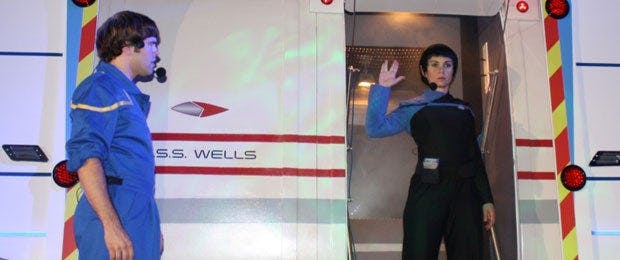
Reid Janisse didn’t know it at the time, but back when he was 20 years old he had his seminal Star Trek experience, the one that would come in tremendously handy as he set about directing Star Trek Live, the new, interactive Star Trek production from Mad Science, which deftly – and entertainingly -- blends together education, science and Star Trek. “I’d been a fan since I was a teenager, pretty much,” Janisse recalls. “I started watching Star Trek: The Next Generation, and I got really into it. But when I was 20, I was hired by Paramount Parks to be a Ferengi at one of their parks. So I had a week of Star Trek training and then I spent an entire summer in a Ferengi costume, walking around the park, doing one-on-one chats with people, doing interactive demonstrations and scenarios, and I took upon this persona named Yog, son of Glorb. And I spent my summer as this Star Trek character. It was probably the best job I ever had until now. I got to spend the whole day improvising, playing this character. It was myself and my Klingon counterpart and the two of us just lived in this Star Trek universe for the entire summer and met tons of amazing people and just had an incredibly good time.” These days, Janisse is a Mad Science regular, a writer and director who’s logged 10 years with the company, a respected, award-winning producer of live, science-driven entertainment presentations. And, as noted, Janisse’s current project is Star Trek Live. The show began previews on May 31 at the Kennedy Space Center with its premiere on June 11 and shows running there through September 6. Meanwhile, a touring edition of Star Trek Live will kick off in San Diego on June 11, then head to Boise, Saskatoon, Charlottesville, Birmingham, Billings, Tacoma and other cities across the U.S. and Canada throughout 2010 and into April 2011. So, what exactly is Star Trek Live? “I think what people are going to see when they walk into the theater is an exciting interactive show that’s going to be fun for people who are Star Trek fans, but also for people who aren’t familiar with the franchise at all,” Janisse told www.startrek.com during a recent, exclusive telephone interview from his home in Toronto, Canada. “We worked very hard to make sure that it’s accessible to everyone. It’s a family show, so it will be fun for adults and children alike. And if I was going to give you a plot synopsis, I would say that a renegade Romulan has come to the planet Earth to try to steal a scientist before they reach their full potential, and a Vulcan beats the Romulans to Earth and tries to help the humans stop the Romulan and keep the timeline in order. The show is set in the present day and to solve all the problems in the story we use a blend of present-day technology and Star Trek technology. So you’ve got real NASA science that exists today and some cool science-fiction.” Janisee sounds particularly jazzed about the interactive elements of Star Trek Live. Much of the show is set at Starfleet Academy and, essentially, audience members are cadets at the Academy. Everyone participates in some way, but a lucky few in the audience are brought directly into the action, exchanging dialogue on the spot with the actors. “The interactive elements were the most exciting part of writing the show and the hardest part, too,” Janisse explains. “There was no way we could just copy things that have already been done. We had to develop an entirely new concept of having a plot and a live stage show, but also being able to bring our guests into the experience in a way that is fun and easily accessible for them and the audience, and that isn’t threatening. So it was exciting to do that, to brainstorm ideas and find a way to bring the Star Trek universe to an entire audience – adults and kids, Star Trek fans and newcomers -- and get them involved. “There are huge risks, but also huge payoffs,” Janisse continues, acknowledging that during one performance someone from the audience might be absolutely perfect, but that during another someone may try to elicit a smile from Voula, the main Vulcan character. “When an audience comes and sees a show that’s very straight and stagnant they don’t get to see the full range of what the actors can give them. In our show, you have the performance that’s scripted, but also the improvised elements, and you really get to see the actors – and the characters – in different situations, thinking on the spot. And that creates a much richer character and performance for the audience, because they know this is happening in real time, right in front of them, and it’s very impressive. Plus, the risk gets diminished by hiring really good people. Part of our casting process involves quite a bit of improvisation, and we hire people with not only acting training, but improv training as well. And we, during the rehearsal process, practice improv. We especially did that with the Vulcan character, actually, because she really has to stay in character the whole time. And when they do that during a show, when you have a human interacting with a Vulcan and the Vulcan staying completely in character, it’s just a huge, huge payoff.” For more information on the tour schedule, visit Upcoming Events.
